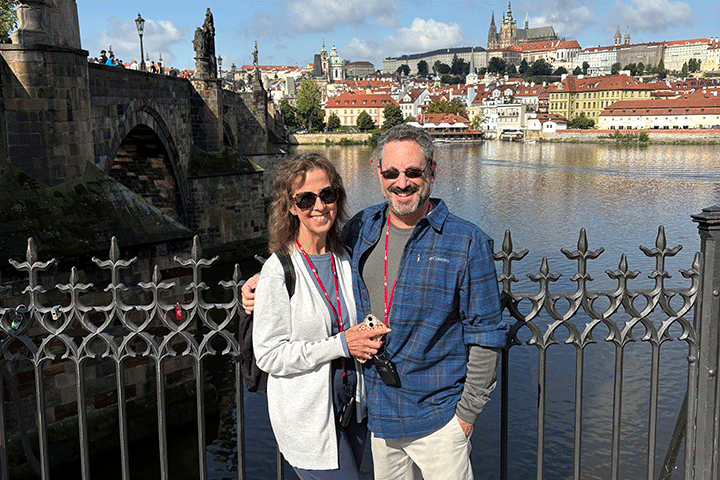Quality of Life and Following My Dream

- Chronic pancreatitis lead to IPMN diagnosis
- Distal pancreatectomy as treatment
- Pancreatitis continues, malignant cells found
- More pancreas removed, plus radiation and chemotherapy
In August 1998, an accident while doing yard work at home led to a diagnosis of pancreatitis and eventually pancreatic cancer.
I banged my abdomen pretty badly, so three days after I hurt myself I went to the local hospital, a rural facility in Michigan. I said, “I think I have an internal injury . . . and that needs to be checked out.” Their diagnosis: pancreatitis. So began my odyssey with issues relating to the pancreas.
Over the next 10 years I was in and out of hospitals with pancreatitis, first in Michigan and then in North Carolina, where we moved in 2003. At one point a CT scan revealed a pseudocyst, but the doctors told me “it will resolve by itself.” After a hospitalization in North Carolina I was told that I have diabetes because of the damage to the pancreas. By the end of 2008 I was unemployable due to chronic pancreatitis but had no money for healthcare. My only option was to enter the Veterans Affairs health system. I didn’t know it at the time, but that was the thing that saved me.
Diagnosis: IPMN
Three days after enrolling with the VA I was again an in-patient for pancreatitis. This time the outcome was vastly different. The pseudocyst was diagnosed as an intraductal papillary mucinous neoplasm (IPMN) and in early summer of 2009 I underwent a distal pancreatectomy at VA Medical Center (VAMC), in Durham, North Carolina. The surgery was performed by surgeons from Duke University Hospital, which is the paired teaching facility for Durham VAMC.
Even though clear margins were not obtained from the resection, there was no attempt at concurrent radiation and chemotherapy. I developed an incisional hernia, which required a large mesh repair that took a long time to heal properly.
The surgery did not alleviate the pain and the recurring acute pancreatitis. I was in-patient every four or five months. Twice a year I would travel to VAMC Durham for an upper endoscopic ultrasound (EUS). CT scans were done every time I was in-patient at VAMC Salisbury and VAMC Durham.
Two days before Christmas in 2014 the results of an upper EUS with fluid biopsy confirmed the presence of malignant colloid cells. Surgery was scheduled for the end of January.
More Treatment But Still Under the Shadow of IPMN
I researched all of the possible surgical options and weighed them against my personal standard of “quality of life.” I determined that I would not accept a Whipple. That procedure was just too extreme. I had been told by a Duke researcher that experiments to regenerate pancreatic tissue were underway and that other research efforts might be available in the long term, but at least some of the pancreas had to remain in place. I elected to undergo a sub-total pancreatectomy followed by concurrent radiation and chemotherapy using capecitabine.
The six-week course of treatment was finished in May of 2015. Although I tolerated the drug and radiation fairly well, my body was severely weakened and it took me a long time to recover.
My CA19-9 level was nearly zero at the end of radiation. Six months after treatment ended that marker had spiked up to 39, causing some concern. It has now been 26 months since the end of treatment. The last 90-day schedule of CT scan and blood testing showed no visible abnormalities and my CA19-9 has dropped into the normal range and now sits at 24.
It is my understanding that IPMN isn’t that aggressive, but it is persistent. I know it will return and may attack another organ. It is disconcerting that by recommended “standard of care” the six-month monitoring regimen will probably go to 12 months if nothing is found on the next visit. It just seems so odd that, believing this will come back within a few years, the standard seems to allow the expected attack to gain traction. Like everything else relating to this malady, my only options are to learn as much as I can and ensure that I receive at least the standard of care. I would like to participate in an appropriate clinical trial when, or if, the IPMN returns.
Following My Dream
I am very focused on quality of life so I am making this an opportunity to do what 99 percent of the population will never attempt—I am following my dreams and living my life as I please. That means touring America by motorcycle, something that has given me joy for 53 years.
At this point I have easily ridden a half million miles. The smiles and wonderful experiences of seeing the entire United States and portions of Canada are what keep me going now. They give me the emotional strength to continue beyond points where others may give up.
My mission now is to visit at least one veterans’ memorial in each county of the lower 48 states. I call the project “Ride Around America.” As of September 2017, I have ridden over 110,000 project miles, visiting monuments and memorials in 1,500 counties within 36 states. To learn more about my mission, visit my Ride Around America website.
On tour days I visit a minimum of five towns a day, riding 250 to 400 miles. The tour itinerary runs up to four weeks, and then I return home to edit photos, research, and write. I try to relate to my readers exactly who and what the names of the fallen represent. If I can help even a few young Americans understand how the local veterans’ memorial can be their personal connection to the history of the United States then I have succeeded in my task.
While touring I try to get interviews with local media, so I can talk about veterans, American history, motorcycle touring, and my desire not to let pancreatic cancer be a reason for me to give up on life.
Many patients consider pancreatic cancer a devastating diagnosis. It does significantly alter a life, but when placed into proper context it can become just another detour of one’s personal journey leading to unexpected accomplishments.
Lee passed away nine years after his diagnosis of a malignant IPMN. He spent as much time as possible riding around America on his motorcycle, honoring military veterans everywhere. We offer our deepest sympathy to his family






